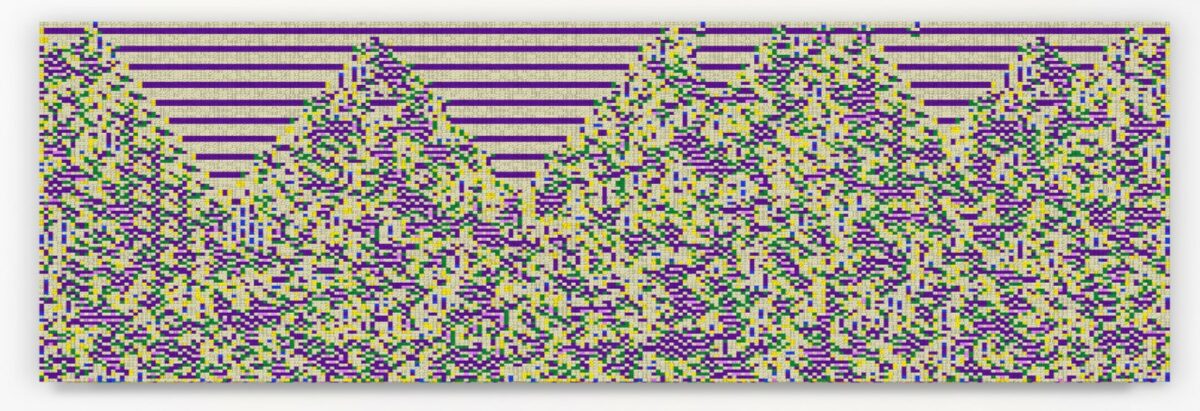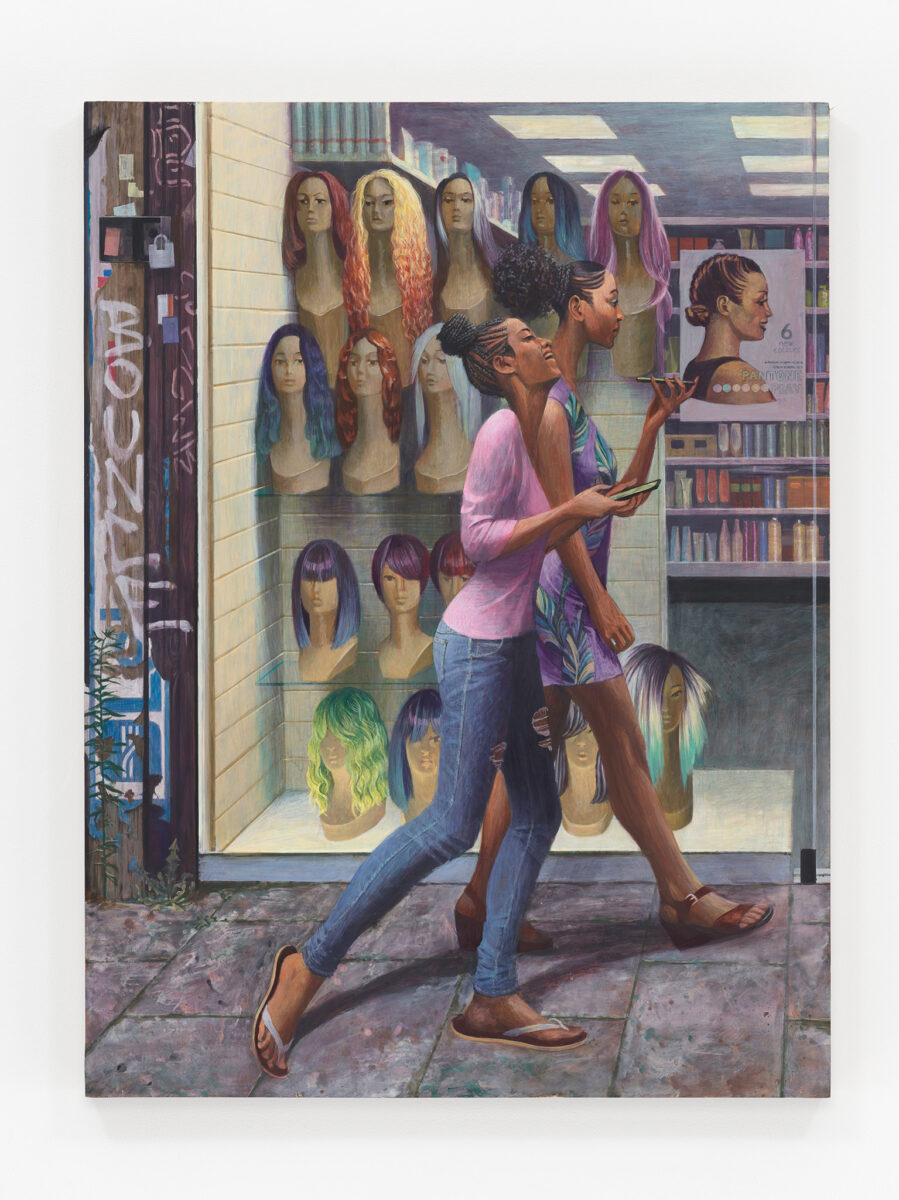
IN THE FRIEZE MIX- Frieze London (to 15 Oct, viewing rooms online to 18 Oct) got slated on its 20th anniversary by Jonathan Jones in the Guardian as having lost its edge, for being too corporate, commercial and safe. I’d say it’s actually the usual galleries showing the usual mix, but without the immediate post-pandemic gratitude that such gatherings are possible. Gagosian made an assertive and successful bid for the ‘worst stand’ prize with paintings by Damien Hirst, but there was also plenty I liked:

Patrick Goddard: ‘Invasion’ 2023, Andy Holden: ‘Infinite Resignation (Unus Instar Omnium)’ 2023, Gabriele Beveridge: ‘Old Joy’ 2023 and Erin O’Keefe: ‘Love Magnet’ 2023 at Seventeen, London
A thousand resin snails by Patrick Goddard overrun Seventeen’s stand in such a Hitchcockian manner that nature threatens to trump the rarefied artifice of the art world. And interesting works are threatened by the infestation, such as Andy Holden’s grandest version yet of his series in which myriad plastic google eyes give the impression that the stars – or maybe the gods – are looking back at us (‘playful material attempts a sweeping eschatology’, says the gallery). Gabrielle Beveridge shows only 94 globes of blown glass lodged in shop fittings, but it’s a start. And at the most molluscan end of the space are Erin O’Keefe’s teasing tableaus of painted wooden shapes photographed to look like paintings…


Troika (Sebastien Noel, Conny Freyer, Eva Rucki): ‘Reality is not Always Probable’, 2023 – dice, 20 cm x 253 cm x 4 cm at OMR, Mexico City
Sticking with ‘quantity’ (of which Frieze generally has plenty) but in the context of quality (not always so evident), this work consists of 32,586 colourful 10mm dice and is generated by manually emulating the rules of a computer program. The digital world is summoned physically while referencing the quiddities of fate associated with throwing dice. The title, a quote from Jorge Luis Borges, evokes ‘disquiet towards a lack of controllable or predictable events and the belief that complete knowledge is impossible’.

Petrit Halilaj: ‘Here to remind you (Polyplectron bicalcaratum)’, 2022 – Brass, natural feather, wood 185 cm x 27 cm x 28 cm at ChertLüdde, Berlin
It’s hard not to be drawn to the synecdoche (part substituted for whole) of attaching just a feather or two to birds’ legs, here from the grey peacock-pheasant. Halilaj has previously made monumental versions of just the legs, implying that the building above was a nest. The recurring presence of birds in the Kosovar artist’s work acts, says the gallery, ‘as a metaphor of the ability to freely overcome geographical boundaries and sociocultural barriers’ although they rarely have wings, which ‘further aligns the birds to the human realm, and indeed, birds have for long carried meanings of intimacy and relationships for the artist’.

Gillian Wearing: ‘My Charms’, 2021 – bronze chain, 3D-printed objects, and mixed media, 240 x 396 cm at Maureen Paley, London
Gillian Wearing multiplies the synecdoches in what might act as a gargantuan necklace of the self. The blue flesh makes sense if you look at it as a post-mortem dissection of elements into a somewhat disturbing memorial, though it may just be that Wearing suffers from cold feet. Either way, ’My Charms’ fits in with her many self-portraits, whether in the masks of others or – during the pandemic – more straightforwardly.

Sofia Hultén: ‘Psychosomatic Neckache # 4’, 2023 – industrial lifting slings, steel excavator teeth, glass, steel suspension links, 192 cm x 108 cm x 22 cm at Galerie Nordenhake, Stockholm / Berlin.
Oddly enough there was another unwearably-sized necklace, this time using industrial slings, designed to pick up weights of over 400 metric tons, as ornamental ribbons. They hold what could be a smartphone more than heavy enough to generate the eponymous neck ache. The title also calls playful attention to phones as causing mental aggravation which could make an illness worse, or as acting between mind and body, depending which definition of ‘psychosomatic’ you fix on. The gallery says that Hultén also sees the ‘phone’ as a black (or ‘Claude’) mirror, historically popular as a means for landscape painters to abstract from the immediate natural impression when regarding the outer world. John Ruskin called that ‘one of the most pernicious tools of falsifying reality’. Maybe he’d have said that of the mobile phone as well.
Two striking installations in the Focus Sector of the fair (for less established galleries) not only shared an aesthetic, but proved to be made by artists who have relocated from unglamorous parts of England – Swindon and Croydon – to Vienna. Moreover, Laurence Sturla’s gallerist is James Lewis’s wife…

James Lewis: ‘Sediment’, 2023 – Wood, steel, plaster bandage, concrete, glass, whiskey, 92 x 254 x 140 cm at Nir Altman, Munich
Networks of tumorous growth, suggesting roots, bring nature into a concrete sofa on which one imagines the absent occupant – apparently a heavy drinker, as several glasses of whiskey add their odour as well as their compellingly whimsical sculptural presence. Together, James Lewis told me, they make up one bottle: the implication of measurement in the context of the life implied fits with Lewis’ wider interest – foregrounded elsewhere on the stand – in challenging ‘the absurdity’ of reducing social and political complexities into statistical data.

Laurence Sturla: ‘Deadgrounds (Winter)’, 2023 – Overfired ceramic, salt and metal fixings – 115 cm x 40 cm x 40 cm at Gianni Manhattan, Vienna
This reads as engine, Frankensteinian figure and landscape. Laurence Sturla made it in clay, cut it into pieces before firing, and then reassembled the pieces, connecting them with bolts. The resulting structure is encrusted with salt and doused with water so that residue form as it dries. The gallery describes it as ‘a coded version of a landscape, disjointed and separated in space’.
Perhaps I’ve given the impression that painting isn’t the main medium in Frieze London, 2023. It is. You have, for example, plenty of options to decide where you want to be on the path from abstraction to representation, the latter being less dominant than it was a couple of years back. Let’s take some examples on the continuum – none of which, as it happens, use straight oil on canvas…

Park Seo-Bo: ‘Ecriture No. 221216’, 2022 – Acrylic on ceramic. 74 x 94 cm at Tina Kim Gallery, New York
At almost 92, Korean dansaekhwa master Park Seo-Bo is still developing the ‘ecstatic minimalism’ of the monochrome series – begun in the 1967 – featuring repetitive gestures resembling script. In the 1980s he introduced Hanji paper, layering and scraping the pulp on the wet surface to create more sculptural lines that seem to float on top of the canvas. This century his colour range has expanded in response to nature. In 2022 he collaborated with a ceramicist for the first time, seeing that as introducing another natural element – clay – as well as providing a further means of emphasizing the sculptural objecthood of the work.
 Oliver Beer: ‘Resonance Painting (Down by the River to Pray)’, 2023 – Pigment on canvas, 200 cm x 150 cm at Almine Rech, Brussels, Paris, New York, London, Shanghai.
Oliver Beer: ‘Resonance Painting (Down by the River to Pray)’, 2023 – Pigment on canvas, 200 cm x 150 cm at Almine Rech, Brussels, Paris, New York, London, Shanghai.
You could argue that this painting isn’t abstract, even though it doesn’t show the swimming pool it might summon. Oliver Beer’s ‘The Resonance Project’ (ongoing since 2007) uses vocal performances to stimulate the natural harmonics inside buildings, so that at the right frequency, a room will take on the energy of a singer’s voice. The Resonance Paintings are made by placing a loudspeaker beneath a horizontally oriented canvas that has been scattered with very fine, dry pigment, so that the vibrations of the sound waves in the air move the pigment. Beer explains ‘I’ve always perceived the shape of sound and the relationship between visual forms and music – and with this body of work I’ve been able to deepen this experience, to make music visible and paint with sound.’

Robert Zandvliet: ‘Paradaidha Pontis’, 2023 – Egg tempera and oil on linen 270 cm x 203 cm at Grimm, Amsterdam / New York / London
Here one might describe the Dutch artist as painting a landscape while resisting naturalism by drawing attention to the artifice and gestures of the work. He also riffs on art history by making Monet’s late garden paintings an explicit reference. But what draws one in to the immersive scale of this shimmering green painting is how it creates its own interior space by minimal means… The title seems to conjoin Hindi for ‘Paradise’ with Latin for ‘bridge’, so if you add in France and the Netherlands there’s quite a lot of cultural linkage going on, too.

Bhasha Chakrabarti: ‘Memory (March 28th)’ and ‘Memory (April 1st)’, 2023 – Oil on aluminium each 64 x 48 cm at Experimenter, Kolkata / Mumbai
The fluid application of paint and choice of an aluminium ground, very visibly exploited, pulls these – from a series of four flower paintings – towards more abstract approaches. Their narrative explains the title: Chakrabarti painted them from bouquets sent to her regularly by an ex-lover – who presumably maintained some hope – following the painful break-up of a relationship. Hence the precise dating of the titles, tracing the passage of time involved in both their making and their distance from happiness – hence the symbolic decision not to paint the flowers until they, too, were dying.

Benjamin Senior: ‘Colour Play’, 2023 – Egg tempera on wood panel, 80 x 60 cm at Carl Freedman Gallery, Margate
Perhaps you don’t have to leave Croydon to get ahead: Benjamin Senior has turned towards its street scenes as a subject to capture through the intensely organised application of an early Renaissance technique, building the image up through dozens of thin layers of egg tempera. ‘Over time’, says Senior, ‘the colours are carefully tuned; figures and elements are painted, repainted, revised and swapped out until all the elements synergise with one another. It’s like solving a puzzle, sometimes taking weeks or months before all the pieces fit into place. The result is a highly choreographed frozen moment. Tempera painting brings a hard-edged stillness to the image, which I seek to counter by introducing optical tensions such as repetition, patterns and shifts of scale.’







